Despite relatively little volatility in asset markets, the second quarter was one of our most active from a trading standpoint for the Decathlon strategies. All risk profiles incrementally added equity exposure throughout the quarter. Notably, equity exposure has shifted away from core U.S. growth towards more value-oriented sectors, with an additional emphasis on smaller companies. Nearly all the top contributors to performance within equities over the past 18 months are no longer in our portfolios as of June 30th. While our positioning is further from that of broad market indices than we have been in many years, we view this shift as a large potential opportunity for our strategies.
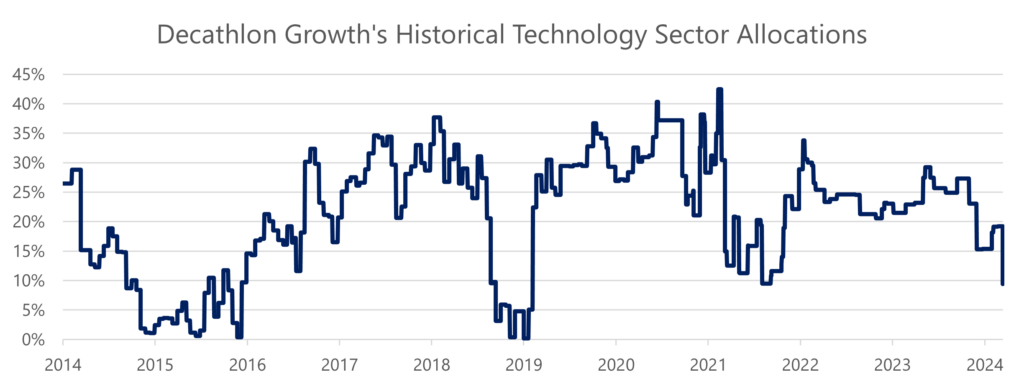
Source: BCM, EOD Historical Data. Data from 4/10/2014 to 6/20/2024. The historical allocation show is an average of the BCM Decathlon Growth Aspect and BCM Decathlon Growth Tactics strategies. The strategies may have different holdings at times but are managed to a substantially similar objective. The sector allocations of the portfolios were determined by looking through to the current underlying holdings of each ETF and applying this data back to the portfolios historical ETF holdings. The sector allocations were determined by EOD Historical Data. The above chart shows a hypothetical allocation and has been provided for illustrative purposes only.
The Growth and Moderate strategies performed slightly below their benchmark asset allocations[1] (net) in the quarter, but roughly matched the performance of their risk-weighted universes. Both strategies are roughly in line with their benchmark asset allocations year-to-date. The weighted ETF universes for the Moderate and Growth[2] strategies, effectively the options our system has to choose from, have underperformed the benchmark asset allocations by 3% and 5.5%, respectively, in 2024—a byproduct of historically narrow market leadership. Thus far excellent selection by our systems has allowed strategy performance to overcome nearly all of this headwind year to date. Should the market environment change, this headwind could become a tailwind for performance.
As the conservative strategy has less of an emphasis on equities, it is less affected by the narrow markets and has substantially outperformed its stated benchmark[3] year-to-date as well as over the quarter. The Conservative model has increasingly looked beyond fixed income for sources of lower risk returns against a backdrop of continued weakness in broad fixed income markets.
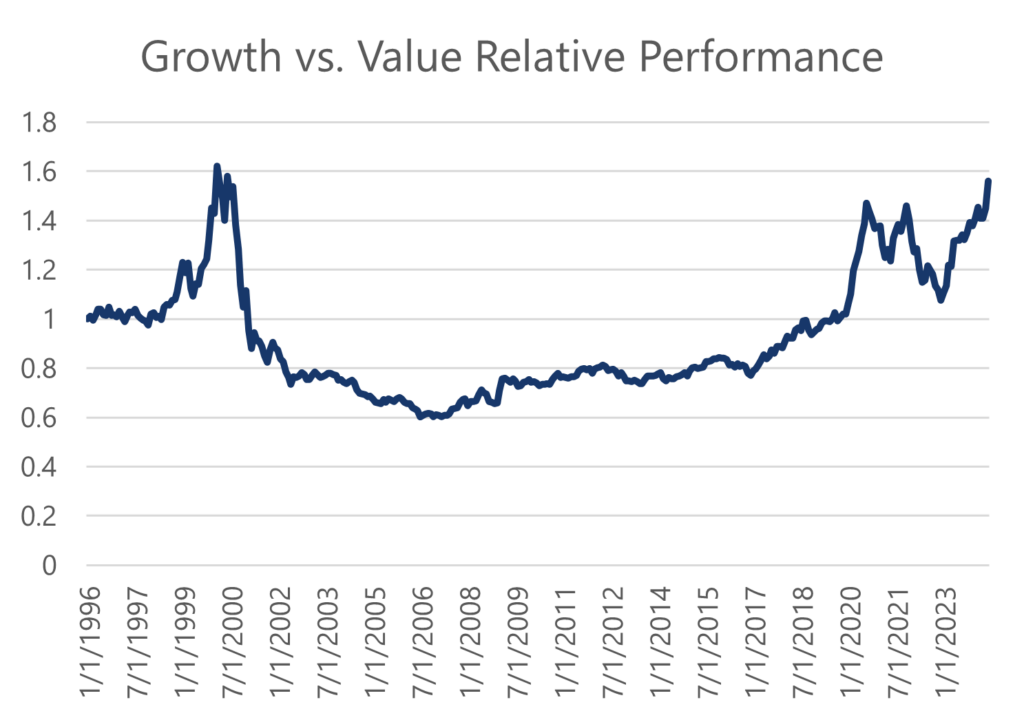
Source: Bloomberg, data from 12/31/1995 through 6/30/2024. Growth and value are represented by the Russell 1000 Growth and Value Indices. The Russell 1000 Value Index includes those Russell 1000 companies with relatively lower price-to-book ratios, lower I/B/E/S forecast medium term (2-year) growth and lower sales per share historical growth (5-years). The Russell 1000 Growth Index includes those Russell 1000 companies with relatively higher price-to-book ratios, higher I/B/E/S forecast medium term (2 year) growth and higher sales per share historical growth (5-years).
By many measures market indices sit at extremes. Concentration[4] and the outperformance of growth stocks are both at historic highs—reminiscent of the tech bubble. While the valuations of the largest companies have expanded during the period, their incredibly strong business results justified much of their market performance in recent years. At the moment, our Decathlon system is suggesting the performance of other equities may “catch-up” to that of the recent winners.
One possible scenario where this plays out is simply that the earnings of the other companies, which thus far have been unspectacular, begin to improve and their share prices follow. Continued economic strength or some abatement of the current restrictive interest rate environment may serve as catalysts. Currently, consensus earnings growth is forecast to accelerate for the “other 494” companies in the S&P 500 while it begins to decelerate for the largest 6 companies (“The Trillionaires”) in the coming quarters.
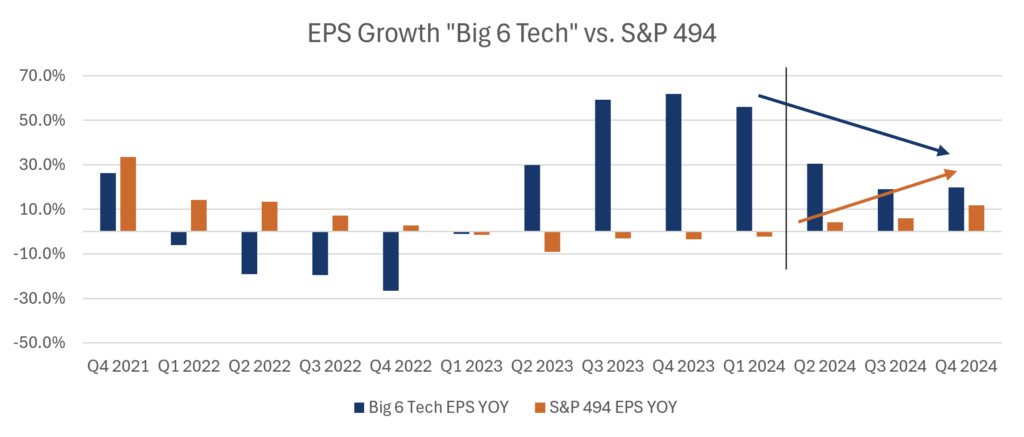
Source: Bloomberg data 12/31/2020 – 6/30/2024. Data through Q1 2024 is actual EPS growth for the six largest technology companies by market capitalization (Microsoft, Apple, Amazon, Google, Meta and Nvidia) as well as the remaining 494 companies in the S&P 500. Data from Q2 2024 through Q4 2024 are based on Bloomberg consensus estimates.
AI ROI – Will the hype become reality?
Alternatively, weakness amongst the largest companies could close the relative performance gap, akin to what occurred during the tech bubble. AI has driven trillions in increased market value and the ultimate impacts could be extremely far reaching, yet thus far only one major company, Nvidia, is truly earning new profits directly from it. Given the sudden massive investment from the world’s largest companies we believe there are only three possible outcomes:
- The incumbent technology companies’ revenue growth or profits increase materially due to their AI investment.
- The incumbent tech companies pull back their investment—AI investment proves cyclical or intermittent.
- The incumbent tech companies are forced to spend more than they have historically via their competition amongst one another in AI – reducing free cash flow and thus market valuations.
Right now, it appears as though the market is betting on “scenario #1” but if either of the two other scenarios play out, the relative performance of the largest tech companies is likely to suffer.
Explanation for chart below:
The chart below extrapolates a 20% growth rate in capital investment from the four largest buyers of cutting-edge data center chips and a 25% growth rate for the makers of those same chips and compares that to the current expectations for the present year 2024. Those growth rates imply a major slowdown in the growth of chip sales over the next few years and also imply a large ongoing investment amongst the large tech buyers assuming their revenue grows at 15% per year over the same period—roughly in line with current trends.
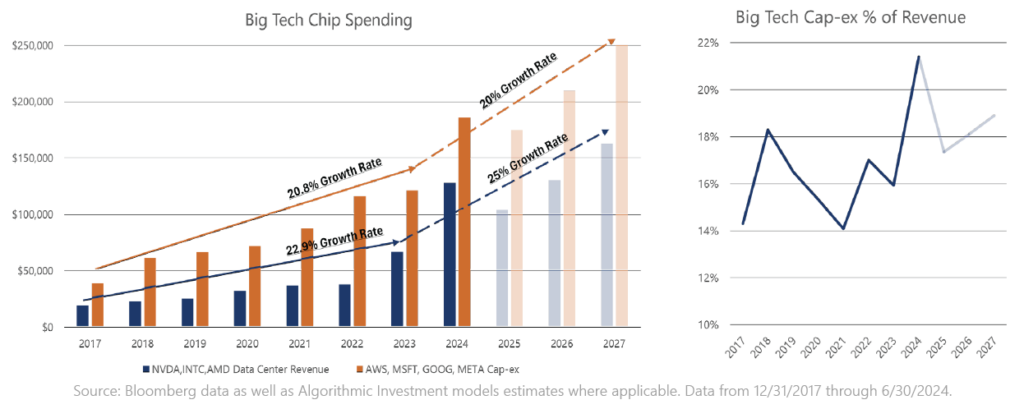
Source: Bloomberg data as well as Algorithmic Investment models estimates where applicable. Data from 12/31/2017 through 6/30/2024.
General Economic Outlook
We continue to believe that rates are “too high” and unnecessarily restrictive. We expect the Federal Reserve to eventually begin following the lead of our European counterparts, who began cutting interest rates over the past quarter. Inflation still appears under control, with recent measures excluding the lagging shelter component even approaching the Fed’s longer-term target.
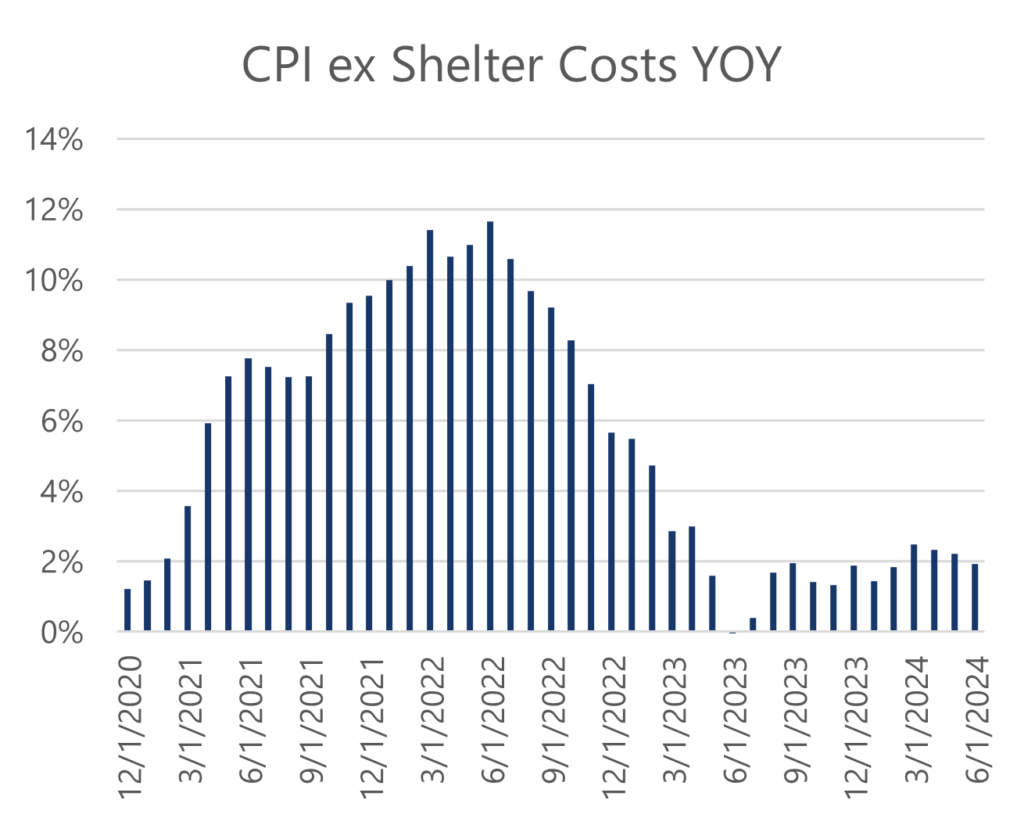
Source: Bloomberg data from BL for the period 6/30/2020 through 6/30/2024
Interest rate and financially sensitive areas of the economy such as housing, auto sales and IPOs[5] continue to show weakness. The supply of homes on the market notably increased in the quarter which could represent a risk to the broad economy given the continued impacts of historically high prices and high interest rates on the demand side of the housing market. If consumers see the value of their homes decreasing it is likely to materially impact their perceived economic position and in turn drive decreased spending.
Outside of the impact of interest rates we see an increasingly obfuscated outlook for the economy. Within the quarter there was some evidence of slowing growth. May retail sales were weaker than expected and the Citigroup economic surprise index fell into negative territory for the first time since 2022. Given that savings rates appear to have normalized, it is certainly possible the U.S. consumer is running out of “ammo,” which would be a major headwind to overall economic growth. However, we still believe the effects of asset appreciation coupled with the demographics of major retirements during covid (depressing the “normal” savings rate) should allow consumers to remain resilient, even if they are unable to spend at the same pace as the last two years.
Markets already appear keenly aware of the upcoming U.S. elections with the implied volatility on S&P 500 index options notably increasing between October and December expirations. While it is hard to refute the idea that the coming elections will be contentious, it appears unlikely that either party will be fiscally restrictive in the near-term. This means less risk to continued economic growth but likely a continued large deficit, which could exacerbate any economic weakness in the future.
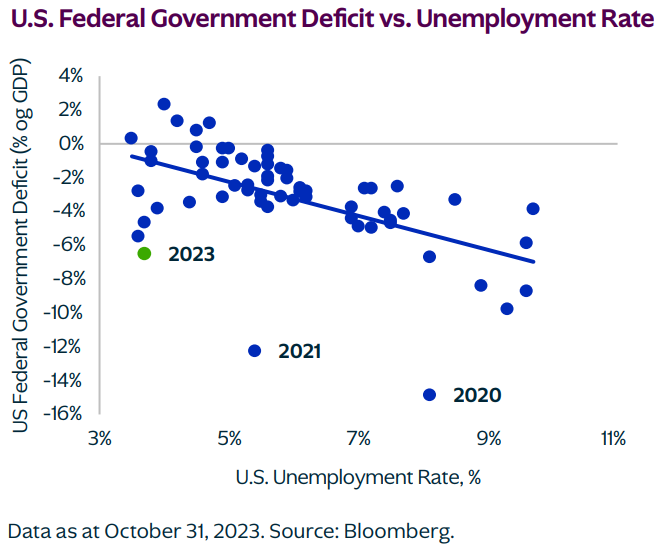
Source: KKR mid-year outlook. 2024-mid-year-outlook.pdf (kkr.com)
We continue to be surprised by the market’s resilience towards current geopolitical tensions, which appear to be the most contentious in many years. A positive resolution on any of these fronts might provide some unexpected upside to parts of the market.
Demand for Electricity
While our models are no longer betting heavily on the direct participants of the AI revolution, they have sought out some of the potential down-stream beneficiaries such as electrical infrastructure, energy pipelines and the businesses that will be financing these new initiatives. Increases in the demand for electrification continue to be a “mega-trend” with a perfect storm of increased data center needs (fueling ever larger AI models), a post-COVID propensity for “onshoring” and broad electrification likely placing significant strain and need for investment on the U.S. energy grid.
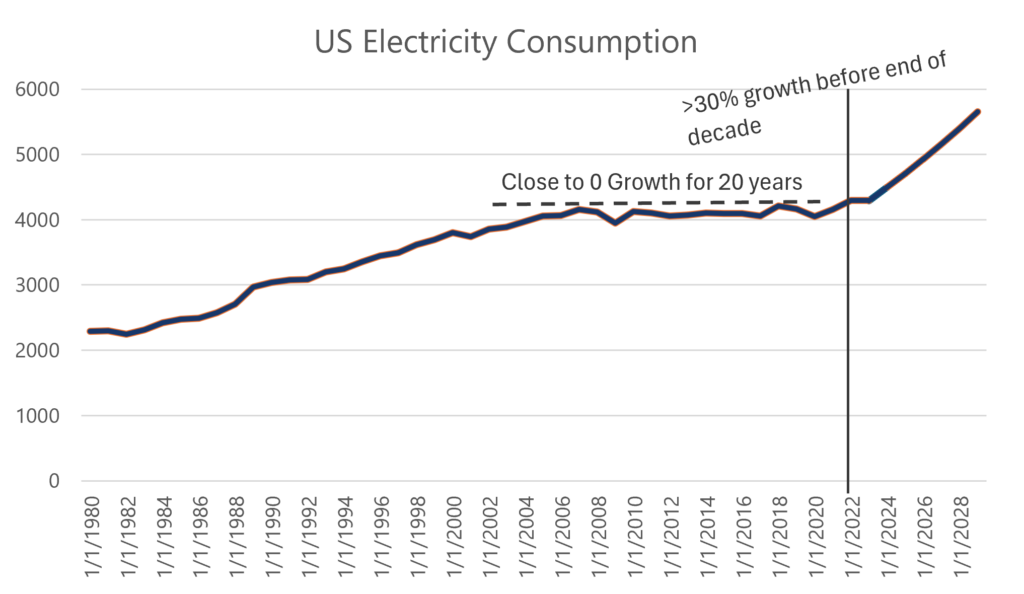
Source: Bloomberg data from EIA, total electricity consumption annually from 1980 through 2022. Projections based on FERC estimates for the next five years.
We expect this theme to continue to make its way into our portfolios in a variety of ways as it plays out over the coming years.
Closing Thoughts
While we have yet to see a sustained changing of the guard in equity markets, we remain excited about our current positioning. Most investors’ portfolios have likely become substantially overweight U.S. growth, both via inertia and by necessity given their relative strength. The potential benefits of being tactical in an environment in which there are few massive winners are far smaller than one in which there are many, or leadership is frequently changing. While we are currently positioned for this change, our system lacks the ego of a human investor who often must be “proven right”. Should a reversal towards value-type equities prove short lived or fail to play out the system can simply return to its prior positioning, a decision that often proves difficult for human investors. Our own human intuition reflects a somewhat murky economic outlook as well as some healthy skepticism over the excitement seen in some corners of the market.
[1] The benchmark for the Moderate strategy is 50% ACWI/50% ICE BofA US Broad Market Index. The benchmark for the Growth strategy is 70% ACWI/30% ICE BofA US Broad Market Index.
[2] 50% of our ETF pool Equities and 50% of the Non-equities for Moderate and 70% Equities/30% Non-Equities for Growth
[3] The benchmark for the Conservative Tactics strategy is 20% ACWI/80% ICE BofA US Broad Market Index. The benchmark for the Conservative Aspect strategy is 15% ACWI/85% ICE BofA US Broad Market Index
[4] The top 10 as a % of the S&P 500 continues to make new historic highs and sits at 34.1% as of June 30th 2024.
[5] May housing turnover was 4% below 2023 turnover and 2023 a s whole was 26% below 2019 levels – source: Bloomberg total home sales 12/31/2018 – 5/31/2024. May seasonally adjusted annualized auto sales (SAAR) are over 11% below 2019 levels as of 5/31/2024.Source: Bloomberg. Capital Markets liduiity (IPOS and Bond issuance total roughly 2.3% of GDP over a trailing 12 months versus a range of 4-7% from 2010 through 2021 source: Preqin, Bank of America, Bloomberg, KKR Global Macro and Asset Allocation analsys 12/31/2010 – 5/31/2024.








